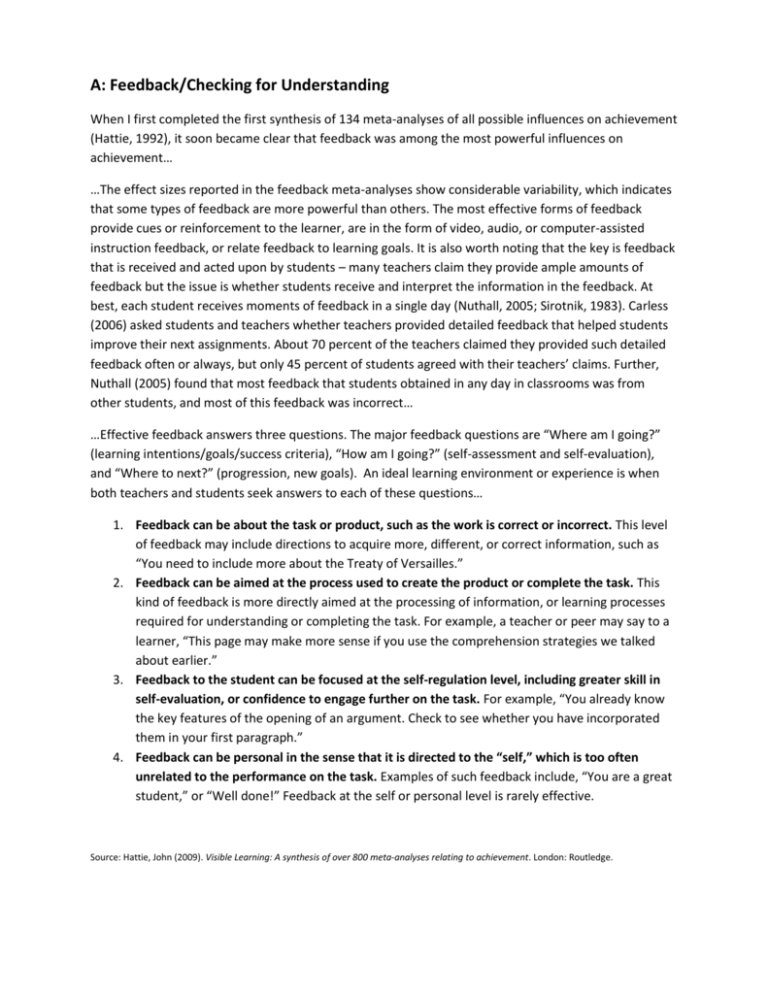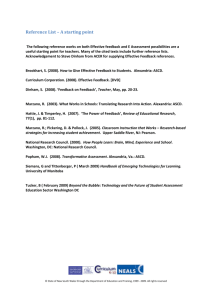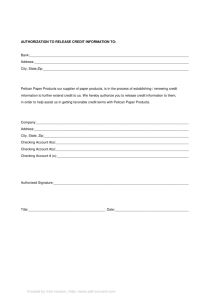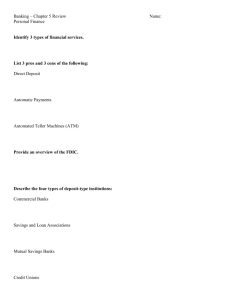A: Feedback/Checking for Understanding
advertisement

A: Feedback/Checking for Understanding When I first completed the first synthesis of 134 meta-analyses of all possible influences on achievement (Hattie, 1992), it soon became clear that feedback was among the most powerful influences on achievement… …The effect sizes reported in the feedback meta-analyses show considerable variability, which indicates that some types of feedback are more powerful than others. The most effective forms of feedback provide cues or reinforcement to the learner, are in the form of video, audio, or computer-assisted instruction feedback, or relate feedback to learning goals. It is also worth noting that the key is feedback that is received and acted upon by students – many teachers claim they provide ample amounts of feedback but the issue is whether students receive and interpret the information in the feedback. At best, each student receives moments of feedback in a single day (Nuthall, 2005; Sirotnik, 1983). Carless (2006) asked students and teachers whether teachers provided detailed feedback that helped students improve their next assignments. About 70 percent of the teachers claimed they provided such detailed feedback often or always, but only 45 percent of students agreed with their teachers’ claims. Further, Nuthall (2005) found that most feedback that students obtained in any day in classrooms was from other students, and most of this feedback was incorrect… …Effective feedback answers three questions. The major feedback questions are “Where am I going?” (learning intentions/goals/success criteria), “How am I going?” (self-assessment and self-evaluation), and “Where to next?” (progression, new goals). An ideal learning environment or experience is when both teachers and students seek answers to each of these questions… 1. Feedback can be about the task or product, such as the work is correct or incorrect. This level of feedback may include directions to acquire more, different, or correct information, such as “You need to include more about the Treaty of Versailles.” 2. Feedback can be aimed at the process used to create the product or complete the task. This kind of feedback is more directly aimed at the processing of information, or learning processes required for understanding or completing the task. For example, a teacher or peer may say to a learner, “This page may make more sense if you use the comprehension strategies we talked about earlier.” 3. Feedback to the student can be focused at the self-regulation level, including greater skill in self-evaluation, or confidence to engage further on the task. For example, “You already know the key features of the opening of an argument. Check to see whether you have incorporated them in your first paragraph.” 4. Feedback can be personal in the sense that it is directed to the “self,” which is too often unrelated to the performance on the task. Examples of such feedback include, “You are a great student,” or “Well done!” Feedback at the self or personal level is rarely effective. Source: Hattie, John (2009). Visible Learning: A synthesis of over 800 meta-analyses relating to achievement. London: Routledge. B: Feedback/Checking for Understanding By providing students with feedback that is corrective, timely, and focused on criteria, and by involving them in the feedback process, teachers can create a classroom environment that fosters and supports learning. The classroom practices featured in this chapter emphasize that the goal of providing feedback is to give students information about their performance relative to a particular learning objective so they can improve their performance and understand themselves better as learners. There are four recommendations for classroom practice with regard to providing feedback: 1. Provide feedback that addresses what is correct and elaborates on what students need to do next. This practice underscores the link between learning objectives and feedback…Feedback should help students understand what was correct as well as contain specifics about what was incorrect. If a student’s performance falls short because he or she is operating from faulty interpretations or hypotheses, feedback should make this clear (Hattie & Timerley, 2007)…Effective feedback should also provide information about how close students come to meeting the criterion and details about what they need to do to attain the next level of performance (Shirbagi, 2007; Shute, 2008). 2. Provide feedback appropriately in time to meet students’ needs. As in many other areas of life, timing is everything (or at least important) when giving feedback. Recent research indicates that the timing of feedback depends on some extent on the nature of the task and on whether students are high-performing or low-performing (Shute, 2008). When students are engrossed in figuring out a difficult task, feedback should be delayed; however, when students can use feedback to complete a task, immediacy helps. Providing immediate feedback can encourage students to practice, and it helps them make connections between what they do and the results they achieve. 3. Provide feedback that is criterion referenced. Feedback should address the knowledge that students are supposed to learn and provide information that helps them know what needs to be done to improve their performance. Obviously, feedback shouldn’t be personal (“You’re smart”), but, rather, it should address performance on a task and provide specific guidance for improvement (“Your response lacks details and includes some inaccurate information. Check the facts about this event, and add details to describe the reasons the event occurred.”). One approach to providing criterion-referenced feedback is to use a rubric. 4. Engage students in the feedback process. Students can provide some of their own feedback and provide feedback to peers. Providing students with opportunities to reflect on their own performance and exchange feedback with peers can help them become lifelong learners (Glaser & Brunstein, 2007; Mooney et al., 2005). It is important to remember, however, that the purpose of peer feedback is for students to clarify for one another what was correct or incorrect about their responses. Students should not give one another grades or scores. Rather, they should serve as “reviewers” who help determine what might be lacking in their performance. Source: Dean, Ceri et al. (2012). Classroom Instruction That Works (2nd ed.). Alexandria, VA: ASCD. C: Feedback/Checking for Understanding Checking for understanding is an important step in the teaching and learning process. Unless you check for understanding, it is difficult to know exactly what students are getting out of the lesson. Research suggests that an important part of the learning process in all content areas is identifying and confronting misconceptions that can interfere with learning. The act of checking for understanding not only corrects misconceptions; it can also improve learning… …We’ve organized this book, and the ways that teachers can check for understanding, into larger categories, including: 1. Using oral language to check for understanding: a. Retelling – re-create the text (or new learning) in your own words b. Think-Pair-Share – cooperative discussion strategy c. Whip-Around – every student answers aloud 2. Using questions to check for understanding: a. Response cards – mini white-boards held up simultaneously b. Hand signals – thumbs on chin, 1-4 scale… c. ReQuest (reciprocal questioning) – ask the expert 3. Using writing to check for understanding: a. Interactive writing – sharing the pen with the teacher b. Read-Write-Pair-Share – cooperative discussion strategy following writing c. Summary writing – re-create the text (or new learning) in your own words in writing 4. Using projects and performances to check for understanding: a. Readers’ theatre – students perform the reading b. Graphic organizers – visual displays of information c. Electronic and paper portfolios – a collection of items reflecting a body of work 5. Using tests to check for understanding: a. Multiple choice – easy to analyze, quicker checks b. Short answer – measure students’ ability to recall specific information c. Essay – offers opportunity to demonstrate deep, organized knowledge 6. Using common assessments and consensus scoring to check for understanding. Five steps for successful use of common assessments and consensus scoring: a. Create/Access pacing guides b. Select instructional materials, strategies, approaches, and arrangements c. Administer common assessments d. Score assessments together and conduct item analysis e. Revise pacing guide, review assessments, reteach, and provide interventions Source: Fisher, D. & N. Frey (2007). Checking for Understanding: Formative assessment techniques for your classroom. Alexandria, VA: ASCD. D: Feedback/Checking for Understanding Questions can stimulate engagement for two reasons at least. First, they are a form of missing information; second, they tend to put mild pressure on students. When used effectively, questioning techniques can be one of the most flexible and adaptive tools in a teacher’s arsenal. This action step addresses four aspects of effective questioning: 1. Wait time. There are several variations: a. Post-teacher-question wait time. Teachers should allow at least three seconds for a student to respond. The teacher might even remind students to take a moment to think before they answer. b. Within-student pause time. When students are answering a question, they sometimes pause. Students should be provided with adequate time to think during such pauses (again, three seconds is advisable). c. Post-student-response wait time. After a student has responded and while other students are considering volunteering, a small pause helps students focus. 2. Response cards. When the teacher asks a question, every child records his or her answer individually. On a cue from the teacher, the students hold up their response cards (a piece of paper or a mini white-board, for example). It is sometimes useful to have students present their response cards in such a way that only the teacher can see. 3. Choral response. When used appropriately, it can be an effective way of engaging students (Becker, 1998). It is best accomplished when important information is stated in a short phrase or sentence and students appear to be having difficulty with the information. The purpose of choral response is to review an important generalization or principle about which there seems to be some confusion. Example: “Repeat it with me…again…one more time…” 4. Response chaining. This refers to linking or chaining students’ responses. Response chaining begins by asking a question to which a specific student responds. The teacher then asks the class as a whole to vote regarding the accuracy of the student’s response using three options: the answer was correct, partially correct, or incorrect. The teacher selects a student who has voted correctly, and that student either corrects the original answer, builds upon that answer, or answers a new question. Source: Marzano, Robert (2007). The Art and Science of Teaching. Alexandria, VA: ASCD.







